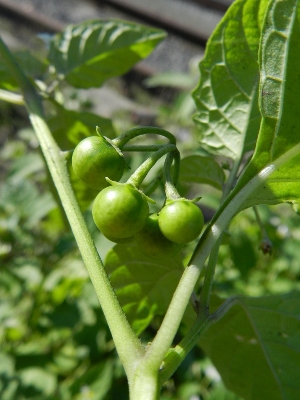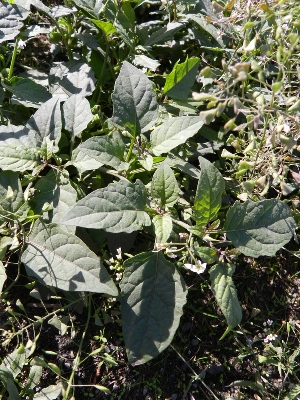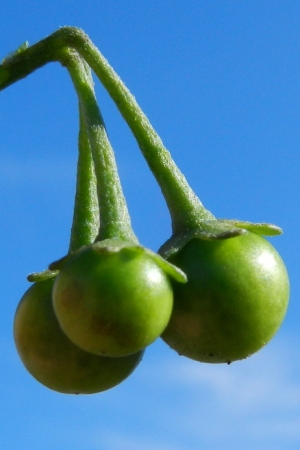10. Solanum ptychanthum Dun. (N-Am.) – A very rare and ephemeral but possibly overlooked alien. Recorded as a grain alien in the port of Gent in 1995 and 1997 (on sandy waste ground at the Ghent Grain Terminal). Also seen in the garden of the author in Hooglede in 2009, in a place where soybean waste was discarded ca. ten years before. Since 2011 Solanum ptychanthum has been observed in relative abundance on sandy, regularly worked-up soil by a railway track in the port of Gent (Farmanstraat), along with several other, naturalised American species of Solanum (S. physalifolium, sarachoides and triflorum). Its future naturalisation in this area is not unlikely. In the latter location these plants have been confused with glabrous forms of Solanum villosum. Both indeed have distinctly angled stems with (very) narrow wings and relatively few-flowered inflorescences. However, at maturity they are easily distinguished on berry colour. Before berries mature separation is also straightforward: in berries of Solanum ptychanthum sclerotic granules (i.e. stony, spherical concretions) are always present (usually at least 6 in number) while these are always absent in S. villosum.
The few Belgian collections have berries with (on average) 9-14 sclerotic granules, a typical feature of Solanum ptychanthum (Schilling 1981, Bassett & Munro 1985, Lemke 1991,…).
It is somewhat uncertain if the name Solanum ptychanthum is correctly applied. Typical features (the number of sclerotic granules) are absent from Dunal’s original description. We here follow Nee (1999) who accepted Solanum ptychanthum as a good species.
Modern authors seem to apply a broader species concept in this group and only accept a single species for which the oldest name is S. americanum Mill. (Särkinen & al. 2018). It includes not only S. ptychanthum but also S. nodiflorum.
 |
 General habit General habit |
|
Umbellate and racemose inflorescences of S. ptychanthum (left) and S. nigrum (right) |
 |
 |
 Two sclerotic granules on the left, seeds on the right Two sclerotic granules on the left, seeds on the right |
|
Typical umbellate inflorescence |
Remains of purplish colour on lowerside leaves |
|
|
Selected literature:
Bassett I.J. & Munro D.B. (1985) The biology of Canadian weeds. 67. Solanum ptycanthum Dun., S. nigrum L. and S. sarrachoides Sendt. Can. J. Plant Sc. 65: 401-414.
Lemke D.E. (1991) The genus Solanum (Solanaceae) in Texas. Phytologia 71(5): 362-378.
Nee M. (1999) Synopsis of Solanum in the New World. In: Nee M. & al. (eds.), Solanaceae IV: Advances in Biology and Utilization. Royal Botanic Gardens, Kew: 285-333.
Särkinen T., Poczai P., Barboza G.E., van der Weerden G.M., Baden M. & Knapp S. (2018) A revision of the Old World Black Nightshades (Morelloid clade of Solanum L., Solanaceae). PhytoKeys 106: 1–223. [available online at: https://doi.org/10.3897/phytokeys.106.21991]
Schilling E.E. (1981) Systematics of Solanum sect. Solanum (Solanaceae) in North America. Syst. Bot. 6: 172-185.




